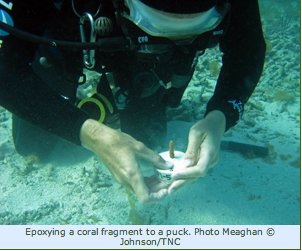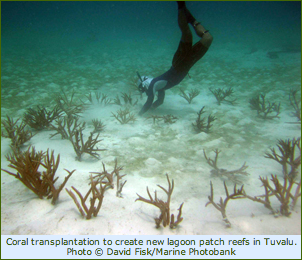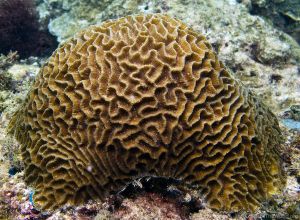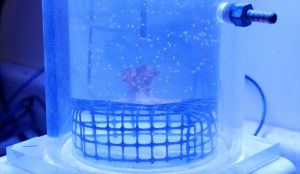CoralTransplantation
Coral Transplantation
What is coral transplantation?
Definition
Coral transplantation can be defined as the physical relocation of coral from a site of inhospitable conditions to an area where the coral is more likely to thrive. According to Edwards and Clark (1999), "the primary objectives of coral transplantation are to improve reef ‘quality’ in terms of live coral cover, biodiversity and topographic complexity."[1] Therefore, coral transplantation may be implemented in order to move live coral in danger of destruction to a transplant site that may provide a more hospitable environment. It may also be implemented to rebuild a damaged or deteriorating site using healthy donor coral from a seperate site. Scleractinian corals are the most common corals used in transplantation.
Benefits and Disadvantages
There are many reasons a community might choose to transplant coral.
First, the immediate increase in live coral cover after coral transplantation can be especially appealing and encouraging to the community. Improving the aesthetics of a less diverse and coral-sparse reef directly benefits the tourism industry in coastal areas. With increased coral cover, rugosity and the number of sheltered locations for other marine organisms also increase, establishing a functional and diverse coral reef ecosystem. In addition, there is increased coral recruitment, which is the addition of coral juveniles (planula) in the coral reef that settle themselves and become polyps.
In spite of the many advantages of coral transplantation, there are some disadvantages that must be considered. Transplanting coral often requires removing coral, whether it be a fragment or a whole colony, from a coral reef. This can cause loss of diversity and coral abundance in the donor site by eliminating the opportunity for a removed coral fragment to establish itself at its donor site and producing a new colony.
Many precautions must be taken when removing coral from a donor site to ensure it will cause minimal effects on the ecosystem present. Transplanting coral causes stress to the corals being moved and can result in reduced growth rates, higher mortality rates, and reduced fecundity of the stressed corals.
The high cost of the procedure also makes coral transplantation risky if the corals being moved are unable to survive or compete with the corals already existing at the transplant site. There is also the risk of attachment failure which happens when the transplanted corals are not able to properly attach to the substrate at the transplant site or the man-made structures provided for the transplantation. Death of the coral follows attachment failure[2].
Methods


Required conditions
Corals have specific conditions which must be met in order for them to survive and thrive. These include suitable temperatures, turbidity, water quality, depth, and others. To have a successful coral transplantation, conditions must be appropriate for the corals to experience minimal amounts of stress during and after transplantation. Timing of the transplantation is also critical. In a study in the Eastern Mediterranean Sea, fish species that were able to efficiently consume algae and clear substrates for coral recruitment and growth allowed effective succession of corals after a large portion of the overgrown algae had been consumed. Precautions must also be taken to ensure that seasonal differneces and currents are appropiate for coral transplantation to reduce transplantation rejectioin[3].
Ways To Grow Coral
Coral fragments broken off by storms or other means can be transplanted to labs or nurseries for further growth. Planulae, or coral larvae, can also be cultured in labs and taken to nurseries for growth. After the planulae is mature enough to thrive in the wild, the coral is then planted at the transplant site. An alternative method involves taking either these fragments or whole colonies, and transplanting them directly to a transplant site without the intermediate use of a nursery[4].
Attachment methods
- Cement: This involves cementing the coral to a cement base then is then placed on the ground of the transplant site. It can be attached to the ground by cable ties.
- Steel ties: This method involves attaching cable ties to the coral and then driving the other end into the ground to hold them in place.
Microfragmenting
Microfragmenting is a technique where scientists cut up living coral into tiny pieces consisting of less than 10 polyps and then transplanting them next to each other. The corals exhibited a behavior that made it seem as if they wanted to grow back together as quickly as possible. Microfragmenting showed coral growth rates in massive corals that were many times the normal rate. [5]
Related studies
British Virgin Islands

Elkhorn coral is a threatened species in the British Virgin Islands. In a study conducted by marine ecologist Dr. Graham Forrester, researchers took coral fragments that had been broken off by storms and transplanted them to a restoration site.The coral fragments were then replanted to barren ground. They found that the corals reattached themselves after approximately 3 months, and became large adult corals after 4 years. The methods described above required little training and could be done by volunteer recreational divers. [6]
Maldive Islands
In the Maldives, a team of scientists selected a reef flat that had been degraded due to coral mining to study growth and mortality rates. Several species of whole coral colonies were transplanted and cemented into place on the reef flat and researchers found that:
- Acropora hyacinthus had the highest mortality rates (50% in two years)
- Porites lobata had the lowest mortality rates (2.8% in two years)
- Acropora divaricata had a high growth rate with relatively low mortality.
The results concluded that the species transplanted needs to be selected with care. The results were compared to other studies as well, and it was concluded that whether fragments or whole colonies are transplanted influences survival. There is a higher mortality rate at higher energy sites. The success rates suggested that coral transplantation should only be conducted when natural recovery is highly unlikely. [7]
St. John
A study conducted off of St. John Island (U.S.V.I) used storm-produced fragments of elkhorn, staghorn and finger corals. The fragments were moved from inhospitable habitats to other reefs. Cable ties were used to secure the fragments to the sea bottom of dead coral. Survival rates were found to be low for all species. One-third died from bleaching, disease, and predators, while the other two-thirds died from physical displacement. This suggested that cable ties were not the most effective method for reef reconstruction. [7]
St. Croix
In 2021, the Nature Conservancy opened their coral laboratory and land-based nursery on St. Croix that was entirely devoted to coral reef restoration. In April 2023, they received a $6.2 million grant from the Department of Commerce for their Virgin Islands Transformational Reef Restoration Program. This project will restore 90 acres of coral reefs on St. Croix, focusing specifically on five species of threatened coral including staghorn and elkhorn coral. Coral will be sourced from donor corals that have survived bleaching events and disease in an effort to support the reef's health and increase resilience[8].
Philippines
This study was designed to document the richness and abundance of different coral reef species due to the effects of coral transplantation of adult coral colonies, and to compare these characteristics at sites with and without coral transplants. Greater species richness and abundance were found at transplant sites compared to neighboring sites not receiving transplants and control sites over 100 meters from the transplant sites. This confirmed that the transplanted corals were responsible for the increased species diversity, and that organisms were not exchanged between the sites, because the empty plots and control plots had similar species diversities. Whole coral colonies were taken from degraded sites to undisturbed sites. Most of the corals were attached to bare rock surfaces with cement. Some sites attached the coral with green plastic screens that the transplants were tied to. The changes in diversity of the sites were then studied. The sites that used the plastic screens had in increase in the number of taxa present, and then began to decrease. The sites that used cement showed a small but steady increase in the number of taxa present. The study discouraged the movement of whole coral colonies, except in extreme cases where the coral will not rehabilitate on its own. [9]
Further Research Needs
As each year passes, more studies are published surrounding coral transplantation and restoration. With this research comes the opportunity to examine the effects of short-term transplantation projects vs. longer-term projects and studies. A majority of most coral conservation projects are short term, lasting no longer than four years and are highly dependent on government funding or foundation grants. Future research into supporting long-term conservation projects and supporting coral biodiversity could greatly increase our understanding of coral reef restoration practices.
Opportunities with Selective Breeding
What Is Selective Breeding, and why do it with Coral Reefs?
Coral reefs are currently facing the severe threat of global warming. Many coral species are dying off because of their inability to withstand the warmer waters. However, there are many different varieties of coral in the world, and some varieties are better suited to face the warmer conditions than others. This creates the opportunity to use selective breeding as a way to minimize the damage of global warming to coral reefs. Selective breeding is the process of purposely breeding organisms in order to create offspring with desirable characteristics[10]. In the instance of the coral reefs, the desirable characteristic is the ability to withstand warm water.

Testing Selective Breeding for Heat Resistance
According to a study done by The Conversation, research shows that corals taken from the world’s hottest seas can pass down helpful genes linked with heat tolerance to their offspring, even in circumstances where they are crossbred with corals that have never undergone those high temperatures[10]. An example of corals that are more suited to higher temperatures are the Platygyra daedalea corals from the Persian Gulf[10]. In the study done by The Conversation, pieces of the coral species platygyra daedalea were taken from the Persian Gulf and crossbred with the same species taken from the Indian Ocean. The resulting offspring was then heat stressed, and the result was an 84% increase in survival at higher temperatures[10]
Selective Breeding Implications
This research shows that it is possible for scientists to create much more hardy corals with selective breeding, which gives them a fighting chance to face the drastically rising sea temperatures. The new, resistant corals that are created are called “super corals”[11]. These super corals provide strong opportunities for coral transplantation, since their hardiness makes them a good pick for reef restoration. By selectively breeding corals, scientists are able to create stronger coral species that are better adapted for the increasingly extreme environment they are facing.
Super Corals
What are super corals?

Super corals are species of coral that are able to withstand the effects of climate change and survive major bleaching events that cause the majority of corals to die off[13]. They are key coral species in adapting to increased global temperature, ocean acidification, and other negative impacts on a once thriving ocean[12]. Typical conservation efforts such as stricter marine laws will not save corals because their biggest threat is caused by the warming ocean which doesn’t show any signs of cooling down. These super corals need to be identified, protected, and reproduced in other ocean communities to protect the future of all marine and terrestrial life.
Breeding super coral
Corals are slow-growing and naturally breed every 100 years, so scientists are taking it into their own hands to recover coral life[14]. . Scientists at UH Manoa’s Institute of Marine Biology are using epigenetics to increase populations of resistant coral[12]. Super corals are taken out of the ocean and are exposed to different levels of heat, light, and acidity. If corals are successful, they are transplanted to areas of rapid decline. Creating super corals is difficult because corals do not like to be touched while they are breeding[14].
Potential Risk
While super corals are becoming increasingly promising in ensuring the future of coral populations, there are still some risks about their widespread existence. One potential risk of super corals is the possibility of disease. If one kind of coral dominates an area because it is so resilient, one disease could wipe out an entire reef[14]. While this risk should be considered, climate change poses an even greater and sure risk to marine life. If these super corals keep growing and persisting, they could be our hope for an ocean that sustains ecological diversity beyond 2050.
Additional Resources
Presentation
http://prezi.com/_u0lbewwjzbr/?utm_campaign=share&utm_medium=copy&rc=ex0share
Lesson Plan
http://coraldigest.org/images/9/96/Coral_Transplantation_Lesson_Plan.pdf
References
- ↑ Edwards, Alasdair J., and Susan Clark. "Coral Transplantation: A Useful Management Tool or Misguided Meddling?" Marine Pollution Bulletin 37.8-12 (1999): 474-87.Science Direct. Web.
- ↑ Abelson, Avigdor. "Artificial Reefs vs Coral Transplantation as Restoration Tools for Mitigating Coral Reef Deterioration: Benefits, Concerns, and Proposed Guidelines." Bulletin of Marine Science 78 (2006): 151-56. Print.
- ↑ http://www.reefresilience.org/Toolkit_Coral/CCRd2_TransplantMethods.html
- ↑ Boström-Einarsson, Lisa, Russell C. Babcock, Elisa Bayraktarov, Daniela Ceccarelli, Nathan Cook, Sebastian C. A. Ferse, Boze Hancock, et al. “Coral Restoration – A Systematic Review of Current Methods, Successes, Failures and Future Directions.” PLoS ONE 15, no. 1 (January 30, 2020): e0226631. https://doi.org/10.1371/journal.pone.0226631.
- ↑ http://www.nytimes.com/2014/11/25/science/a-lifesaving-transplant-for-coral-reefs.html?_r=0
- ↑ http://www.sciencedaily.com/releases/2010/06/100603193925.htm
- ↑ 7.0 7.1 http://www.coralreef.gov/mitigation/transplanttion_rehabilitation.pdf
- ↑ Mayor, P.A. 2006. A summary of biophysical data relevant to the management of the East End Marine Park, St. Croix, US Virgin Islands. The Ocean Conservancy, US Virgin Islands Regional Office, St. Croix, USVI, pp. 131.
- ↑ Yap, Ht. "Local Changes in Community Diversity after Coral Transplantation." Marine Ecology Progress Series 374 (2009): 33-41. Web.
- ↑ 10.0 10.1 10.2 10.3 Anna Scott. “Coral, meet coral: how selective breeding may help the world’s reefs survive ocean heating.” The Conversation. August 20, 2021. https://theconversation.com/coral-meet-coral-how-selective-breeding-may-help-the-worlds-reefs-survive-ocean-heating-166412
- ↑ Damian Carrington. “New lab-bred super corals could help avert global reef wipeout”. The Guardian. December 17, 2017. https://www.theguardian.com/environment/2017/dec/23/new-lab-bred-super-corals-could-help-avert-global-reef-wipeout
- ↑ 12.0 12.1 12.2 Ellis, Lauren. “Behind the Scenes: Breeding Super Coral.” Coral Health Atlas, January 26, 2015. https://hilo.hawaii.edu/coralhealth/news/breeding-super-coral.php
- ↑ Adhya, Sarah Wakefield. “The Survival Secrets of ‘Super Reefs.’” The Nature Conservancy, January 17, 2023. https://www.nature.org/en-us/what-we-do/our-insights/perspectives/survival-secrets-super-reefs/
- ↑ 14.0 14.1 14.2 Jones, Nicola. “As Ocean Waters Heat Up, A Quest to Create ‘Super Corals.’” Yale E360, August 4, 2015. https://e360.yale.edu/features/as_ocean_waters_heat_up_a_quest_to_create_super_corals